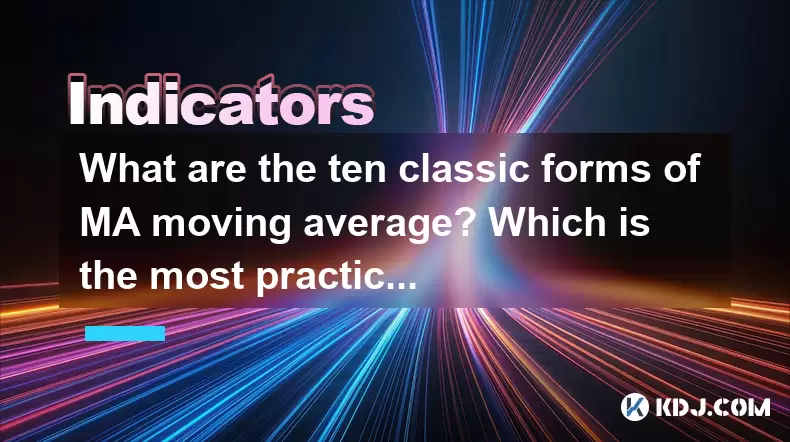-
 bitcoin
bitcoin $114779.865156 USD
2.30% -
 ethereum
ethereum $4226.519789 USD
2.39% -
 tether
tether $1.000545 USD
0.04% -
 xrp
xrp $2.890223 USD
0.92% -
 bnb
bnb $1030.029301 USD
2.95% -
 solana
solana $212.824944 USD
1.69% -
 usd-coin
usd-coin $0.999757 USD
0.01% -
 dogecoin
dogecoin $0.234961 USD
-0.27% -
 tron
tron $0.337174 USD
0.42% -
 cardano
cardano $0.804783 USD
0.09% -
 hyperliquid
hyperliquid $45.748770 USD
-2.85% -
 chainlink
chainlink $21.699170 USD
0.82% -
 ethena-usde
ethena-usde $1.001452 USD
0.08% -
 avalanche
avalanche $30.237800 USD
1.14% -
 stellar
stellar $0.372604 USD
1.52%
What are the ten classic forms of MA moving average? Which is the most practical?
EMA is the most practical moving average for crypto trading due to its responsiveness, simplicity, and versatility in various market conditions.
May 22, 2025 at 09:56 pm

Introduction to Moving Averages
Moving averages (MA) are fundamental tools used in technical analysis within the cryptocurrency market. They help traders and investors smooth out price data to identify trends over time. There are several types of moving averages, each with its own unique characteristics and applications. In this article, we will explore ten classic forms of moving averages and discuss which one is considered the most practical for cryptocurrency trading.
Simple Moving Average (SMA)
The Simple Moving Average (SMA) is perhaps the most straightforward type of moving average. It calculates the average price of a cryptocurrency over a specified period. For example, a 10-day SMA would add up the closing prices of the last 10 days and divide by 10.
- Calculation: SMA = (Sum of Prices over Period) / Number of Periods
- Usage: SMAs are widely used to identify long-term trends. They are less sensitive to recent price changes, making them suitable for smoothing out short-term fluctuations.
Exponential Moving Average (EMA)
The Exponential Moving Average (EMA) is a type of moving average that places more weight on recent prices. This makes it more responsive to new information compared to the SMA.
- Calculation: EMA = (Closing Price - Previous EMA) Multiplier + Previous EMA, where Multiplier = 2 / (Number of Periods + 1)
- Usage: EMAs are favored by traders who want to react quickly to price changes. They are often used in short-term trading strategies within the cryptocurrency market.
Weighted Moving Average (WMA)
The Weighted Moving Average (WMA) assigns a heavier weighting to more recent prices. This approach aims to make the average more reflective of recent market conditions.
- Calculation: WMA = (Price1 n + Price2 (n-1) + ... + Pricen 1) / (n (n+1) / 2), where n is the number of periods
- Usage: WMAs are useful for traders who want to emphasize recent price movements without the complexity of exponential calculations.
Linear Weighted Moving Average (LWMA)
The Linear Weighted Moving Average (LWMA) is similar to the WMA but uses a linear weighting scheme. This type of moving average gives more importance to recent prices but in a linear fashion.
- Calculation: LWMA = (Price1 n + Price2 (n-1) + ... + Pricen 1) / (n (n+1) / 2)
- Usage: LWMAs are used by traders who want a balance between the simplicity of SMAs and the responsiveness of EMAs.
Triangular Moving Average (TMA)
The Triangular Moving Average (TMA) is a double-smoothed simple moving average. It is calculated by taking a simple moving average of a simple moving average, resulting in a smoother line.
- Calculation: TMA = SMA of SMA
- Usage: TMAs are used to further smooth out price data, making them suitable for identifying long-term trends in the cryptocurrency market.
Variable Moving Average (VMA)
The Variable Moving Average (VMA) adjusts its sensitivity based on market volatility. This type of moving average can adapt to changing market conditions more effectively.
- Calculation: VMA uses a formula that incorporates market volatility to adjust the weighting of prices
- Usage: VMAs are useful for traders who want a moving average that can adapt to the often volatile nature of cryptocurrency markets.
Hull Moving Average (HMA)
The Hull Moving Average (HMA) is designed to reduce lag compared to traditional moving averages. It combines the weighted moving average and the square root of the period to achieve this.
- Calculation: HMA = WMA(2WMA(n/2) - WMA(n)), where n is the number of periods
- Usage: HMAs are favored by traders who need a fast and smooth moving average for short-term trading in the cryptocurrency market.
Kaufman's Adaptive Moving Average (KAMA)
Kaufman's Adaptive Moving Average (KAMA) adjusts its sensitivity based on market noise. It uses the Efficiency Ratio to determine how much weight to give to recent prices.
- Calculation: KAMA = Previous KAMA + ER (Price - Previous KAMA), where ER is the Efficiency Ratio
- Usage: KAMAs are useful for traders who want a moving average that can adapt to different market conditions in the cryptocurrency market.
Smoothed Moving Average (SMMA)
The Smoothed Moving Average (SMMA) is a type of moving average that places more emphasis on smoothing out price data. It uses a longer period to calculate the average, resulting in a smoother line.
- Calculation: SMMA = (Previous SMMA (n-1) + Current Price) / n, where n is the number of periods
- Usage: SMMAs are used by traders who want to focus on long-term trends and reduce the impact of short-term price fluctuations in the cryptocurrency market.
Double Exponential Moving Average (DEMA)
The Double Exponential Moving Average (DEMA) is designed to reduce lag while maintaining smoothness. It combines two exponential moving averages to achieve this.
- Calculation: DEMA = 2 * EMA - EMA of EMA
- Usage: DEMAs are used by traders who want a fast and smooth moving average for short-term trading in the cryptocurrency market.
Which Moving Average is the Most Practical?
When considering which moving average is the most practical for cryptocurrency trading, several factors come into play, including responsiveness, simplicity, and adaptability to market conditions. Among the ten classic forms of moving averages discussed, the Exponential Moving Average (EMA) stands out as the most practical for several reasons.
- Responsiveness: EMAs are more responsive to recent price changes, which is crucial in the fast-paced cryptocurrency market. This allows traders to react quickly to new information and trends.
- Simplicity: Despite being more complex than SMAs, EMAs are still relatively simple to calculate and understand, making them accessible to both novice and experienced traders.
- Versatility: EMAs can be used effectively in various trading strategies, from short-term scalping to long-term trend following. This versatility makes them a valuable tool for traders looking to adapt to different market conditions.
Frequently Asked Questions
Q: Can moving averages be used effectively in highly volatile cryptocurrency markets?A: Yes, moving averages can be used effectively in volatile cryptocurrency markets. However, it is important to choose the right type of moving average. For instance, EMAs and HMAs are more responsive to price changes, making them suitable for volatile markets. Conversely, SMAs and TMAs are better for smoothing out price data and identifying long-term trends.
Q: How do I choose the right period for a moving average in cryptocurrency trading?A: The choice of period for a moving average depends on your trading strategy. For short-term trading, shorter periods (e.g., 5-20 days) are typically used. For long-term trend analysis, longer periods (e.g., 50-200 days) are more appropriate. It's also important to test different periods to see which one works best for your specific trading style and the cryptocurrency you are trading.
Q: Can multiple moving averages be used together in cryptocurrency trading?A: Yes, using multiple moving averages together is a common strategy in cryptocurrency trading. For example, traders often use a combination of short-term and long-term moving averages to identify potential buy and sell signals. When a short-term moving average crosses above a long-term moving average, it may signal a bullish trend, while a cross below may indicate a bearish trend.
Q: Are there any drawbacks to using moving averages in cryptocurrency trading?A: While moving averages are useful tools, they do have some drawbacks. One major limitation is lag, as moving averages are based on past prices and may not react quickly enough to sudden market changes. Additionally, moving averages can generate false signals in choppy or sideways markets, leading to potential losses if not used in conjunction with other indicators.
Disclaimer:info@kdj.com
The information provided is not trading advice. kdj.com does not assume any responsibility for any investments made based on the information provided in this article. Cryptocurrencies are highly volatile and it is highly recommended that you invest with caution after thorough research!
If you believe that the content used on this website infringes your copyright, please contact us immediately (info@kdj.com) and we will delete it promptly.
- BlockDAG, DOGE, HYPE Sponsorship: Crypto Trends Shaping 2025
- 2025-10-01 00:25:13
- Deutsche Börse and Circle: A StableCoin Adoption Powerhouse in Europe
- 2025-10-01 00:25:13
- BlockDAG's Presale Buzz: Is It the Crypto to Watch in October 2025?
- 2025-10-01 00:30:13
- Bitcoin, Crypto, and IQ: When Genius Meets Digital Gold?
- 2025-10-01 00:30:13
- Stablecoins, American Innovation, and Wallet Tokens: The Next Frontier
- 2025-10-01 00:35:12
- NBU, Coins, and Crypto in Ukraine: A New Yorker's Take
- 2025-10-01 00:45:14
Related knowledge

What is a tower bottom candlestick pattern? Does it have a high success rate?
Sep 22,2025 at 07:18am
Tower Bottom Candlestick Pattern Explained1. The tower bottom candlestick pattern is a reversal formation that typically appears at the end of a downt...

What is a black hole pattern in the MACD indicator? Is it a cause for concern?
Sep 21,2025 at 06:54pm
Bitcoin's Role in Decentralized Finance1. Bitcoin remains the cornerstone of decentralized finance, serving as a benchmark for value and security acro...

How can I use the psychological line (PSY) to determine market sentiment?
Sep 17,2025 at 02:19pm
Understanding the Psychological Line (PSY) in Cryptocurrency TradingThe Psychological Line, commonly referred to as PSY, is a momentum oscillator used...

How can I determine if a double top pattern has officially formed?
Sep 21,2025 at 03:18am
Understanding the Structure of a Double Top Pattern1. A double top pattern consists of two distinct peaks that reach approximately the same price leve...

What is the Golden Valley pattern on the moving average? Is it better than the Silver Valley pattern?
Sep 21,2025 at 02:54pm
Understanding the Golden Valley Pattern in Moving Averages1. The Golden Valley pattern is a technical formation observed in cryptocurrency price chart...

What does a death cross of the RSI in the strong zone (above 50) mean?
Sep 17,2025 at 10:54pm
Understanding the Death Cross in RSI Context1. The term 'death cross' is traditionally associated with moving averages, where a short-term average cro...

What is a tower bottom candlestick pattern? Does it have a high success rate?
Sep 22,2025 at 07:18am
Tower Bottom Candlestick Pattern Explained1. The tower bottom candlestick pattern is a reversal formation that typically appears at the end of a downt...

What is a black hole pattern in the MACD indicator? Is it a cause for concern?
Sep 21,2025 at 06:54pm
Bitcoin's Role in Decentralized Finance1. Bitcoin remains the cornerstone of decentralized finance, serving as a benchmark for value and security acro...

How can I use the psychological line (PSY) to determine market sentiment?
Sep 17,2025 at 02:19pm
Understanding the Psychological Line (PSY) in Cryptocurrency TradingThe Psychological Line, commonly referred to as PSY, is a momentum oscillator used...

How can I determine if a double top pattern has officially formed?
Sep 21,2025 at 03:18am
Understanding the Structure of a Double Top Pattern1. A double top pattern consists of two distinct peaks that reach approximately the same price leve...

What is the Golden Valley pattern on the moving average? Is it better than the Silver Valley pattern?
Sep 21,2025 at 02:54pm
Understanding the Golden Valley Pattern in Moving Averages1. The Golden Valley pattern is a technical formation observed in cryptocurrency price chart...

What does a death cross of the RSI in the strong zone (above 50) mean?
Sep 17,2025 at 10:54pm
Understanding the Death Cross in RSI Context1. The term 'death cross' is traditionally associated with moving averages, where a short-term average cro...
See all articles










































































